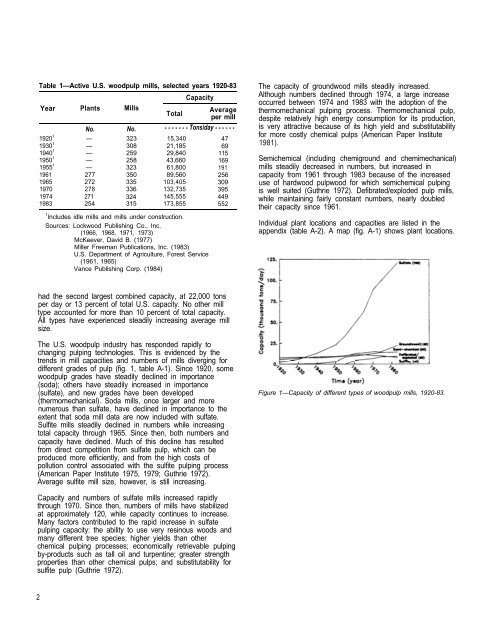The United States Woodpulp Industry - Forest Products Laboratory ...
The United States Woodpulp Industry - Forest Products Laboratory ...
The United States Woodpulp Industry - Forest Products Laboratory ...
You also want an ePaper? Increase the reach of your titles
YUMPU automatically turns print PDFs into web optimized ePapers that Google loves.
Table 1—Active U.S. woodpulp mills, selected years 1920-83<br />
Year Plants Mills<br />
Total<br />
Capacity<br />
Average<br />
per mill<br />
No. No. - - - - - - - Tons/day - - - - - -<br />
1920 1<br />
— 323 15,340 47<br />
1930 1<br />
1940<br />
— 308 21,185 69<br />
1<br />
1950<br />
— 259 29,840 115<br />
1<br />
1955<br />
— 258 43,660 169<br />
1<br />
— 323 61,800 191<br />
1961 277 350 89,560 256<br />
1965 272 335 103,405 309<br />
1970 278 336 132,735 395<br />
1974 271 324 145,555 449<br />
1983 254 315 173,855 552<br />
1<br />
lncludes idle mills and mills under construction.<br />
Sources: Lockwood Publishing Co., Inc.<br />
(1966, 1968, 1971, 1973)<br />
McKeever, David B. (1977)<br />
Miller Freeman Publications, Inc. (1983)<br />
U.S. Department of Agriculture, <strong>Forest</strong> Service<br />
(1961, 1965)<br />
Vance Publishing Corp. (1984)<br />
had the second largest combined capacity, at 22,000 tons<br />
per day or 13 percent of total U.S. capacity. No other mill<br />
type accounted for more than 10 percent of total capacity.<br />
All types have experienced steadily increasing average mill<br />
size.<br />
<strong>The</strong> U.S. woodpulp industry has responded rapidly to<br />
changing pulping technologies. This is evidenced by the<br />
trends in mill capacities and numbers of mills diverging for<br />
different grades of pulp (fig. 1, table A-1). Since 1920, some<br />
woodpulp grades have steadily declined in importance<br />
(soda); others have steadily increased in importance<br />
(sulfate), and new grades have been developed<br />
(thermomechanical). Soda mills, once larger and more<br />
numerous than sulfate, have declined in importance to the<br />
extent that soda mill data are now included with sulfate.<br />
Sulfite mills steadily declined in numbers while increasing<br />
total capacity through 1965. Since then, both numbers and<br />
capacity have declined. Much of this decline has resulted<br />
from direct competition from sulfate pulp, which can be<br />
produced more efficiently, and from the high costs of<br />
pollution control associated with the sulfite pulping process<br />
(American Paper Institute 1975, 1979; Guthrie 1972).<br />
Average sulfite mill size, however, is still increasing.<br />
Capacity and numbers of sulfate mills increased rapidly<br />
through 1970. Since then, numbers of mills have stabilized<br />
at approximately 120, while capacity continues to increase.<br />
Many factors contributed to the rapid increase in sulfate<br />
pulping capacity: the ability to use very resinous woods and<br />
many different tree species; higher yields than other<br />
chemical pulping processes; economically retrievable pulping<br />
by-products such as tall oil and turpentine; greater strength<br />
properties than other chemical pulps; and substitutability for<br />
sulfite pulp (Guthrie 1972).<br />
2<br />
<strong>The</strong> capacity of groundwood mills steadily increased.<br />
Although numbers declined through 1974, a large increase<br />
occurred between 1974 and 1983 with the adoption of the<br />
thermomechanical pulping process. <strong>The</strong>rmomechanical pulp,<br />
despite relatively high energy consumption for its production,<br />
is very attractive because of its high yield and substitutability<br />
for more costly chemical pulps (American Paper Institute<br />
1981).<br />
Semichemical (including chemiground and chemimechanical)<br />
mills steadily decreased in numbers, but increased in<br />
capacity from 1961 through 1983 because of the increased<br />
use of hardwood pulpwood for which semichemical pulping<br />
is well suited (Guthrie 1972). Defibrated/exploded pulp mills,<br />
while maintaining fairly constant numbers, nearly doubled<br />
their capacity since 1961.<br />
Individual plant locations and capacities are listed in the<br />
appendix (table A-2). A map (fig. A-1) shows plant locations.<br />
Figure 1—Capacity of different types of woodpulp mills, 1920-83.

















